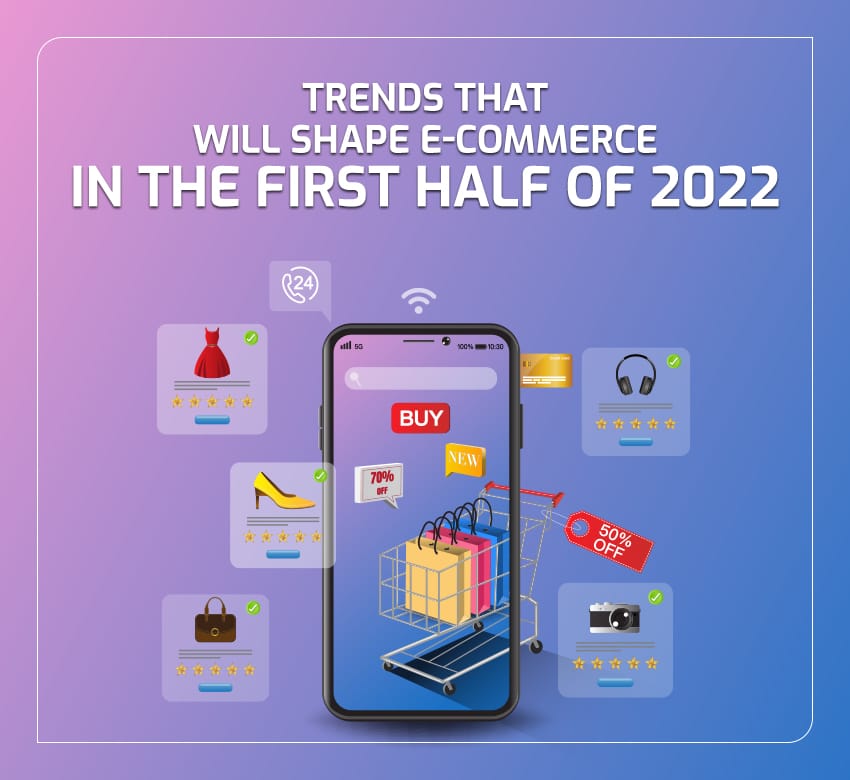
E-commerce is a dynamic industry with continuously changing technology and trends. No surprise, the recent pandemic was a significant game shift for this niche, having both good and bad consequences for all enterprises in this industry. During the lockdown, people drastically altered their shopping habits, prompting businesses to engage in e-commerce platforms and digital marketing.
So, what developments are likely to disrupt the e-commerce market and boost revenue growth for businesses shortly? E-commerce development companies have a wide range of options to choose from as new technologies and new demands arise. They may also try out new channels and techniques. Let’s have a look at the upcoming e-commerce trends for 2022.
1. Headless Commerce Will Expand More
In the e-commerce business in 2022 and the trends that will continue to dominate the industry, headless commerce is unquestionably a solution that will enable your e-commerce platform to be separate from the layer that displays the front end of your website.
Many of our customers choose BigCommerce over other e-commerce platforms due to its headless nature and flexibility. Furthermore, when you include content marketing and SEO into the mix, this trend will show to be a winner for you.
According to a well-known e-commerce architect, headless gives far more control over the content and ensures a seamless user experience till the checkout phase. To fully capitalize on this trend, you should investigate headless integrations.
2. There Will be an Increase in The Demand For Customized Products
The demand for personalized items is expanding. Consumers may pick from a variety of products based on their needs and preferences. It is almost hard to meet customer wants by supplying items organized into distinct categories. As a result, e-commerce companies will use bespoke items to increase the degree of e-commerce personalization. Furthermore, 22% of customers are willing to disclose some data in exchange for customized items.
More well-known businesses have already done so, and smaller ones are anticipated to follow suit. As a result, by 2022, an increasing number of e-commerce firms will use customized personalization choices to boost brand loyalty and make purchasing more engaging.
3. Bitcoin Acceptance as a Payment Mode Will Spread Further
By 2022, numerous e-commerce firms will accept bitcoin as a payment method. The most significant benefit of bitcoins is that no middlemen are required. Payment gateways are used for e-commerce transactions in the present context.
The fact that bitcoin transactions occur directly between the client and the seller means that there is no need to pay a commission. Furthermore, since there would be no chargebacks, e-commerce fraud will be decreased. Bitcoin payment alternatives such as BitPay and Coingate are supported by e-commerce suppliers such as Magento. Similarly, BitPay, Coinbase, and GoCoin are supported by Shopify.
Popular e-commerce platforms will add more BTC support in the next year, leading to widespread adoption of bitcoin as a cheaper, more convenient, and secure payment alternative for e-commerce.
4. Customer Interactions Will Be Managed by Chatbots
According to Gartner, by 2021, 85 percent of firms will handle client interactions without the aid of humans. Furthermore, by 2022, chatbot e-commerce transactions are estimated to exceed $112 billion.
In the future, the present AI-based technologies used to generate chatbots will improve, resulting in increased conversion rates and retention.
Conversational chatbots are the chatbots of the future. Given the pace of chatbot adoption by e-commerce enterprises, conversational chatbots will be supporting consumers in their purchasing journeys in 2022 and beyond.
5. Voice Shopping Will Undoubtedly Gain Popularity
Voice shopping equates to convenience for customers who are always on the go. By 2022, it is expected that the number of voice shoppers will have increased by 55 percent, making it a significant trend to follow. The popularity of voice shopping grew due to Amazon’s Echo, and it has since transformed the digital sector.
However, voice purchasing presents a hurdle since, in most circumstances, it does not include pictures. As a result, people gravitate toward more conventional things such as food, low-cost gadgets, and homeware that do not need much visual study.
The e-commerce business in 2022 will undoubtedly witness a significant increase in voice shopping. Online vendors are advised to embrace this trend to provide consumers with comfort. The year 2022 may be the year for you to give it a go if you haven’t before.
To Conclude
The e-commerce trends to look out for in 2022 point to a bright future for the industry. These results indicate that the industry has a great deal of potential for growth in the next year. As a consequence of the rise of online shopping, the appearance of e-commerce websites has changed.
E-commerce businesses must constantly monitor and analyze changing market circumstances to stay one step ahead of the competition. They should provide an excellent customer experience and be quick to adopt new technology. As suggested by these trends, there will be enormous possibility for growth and innovation in e-commerce in 2022.


